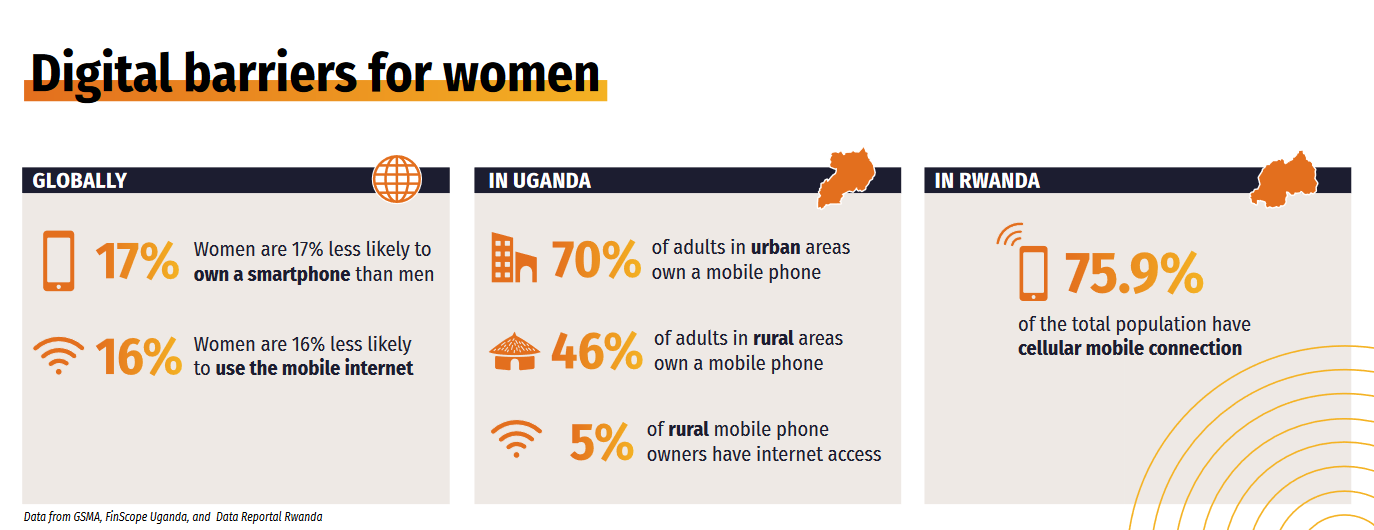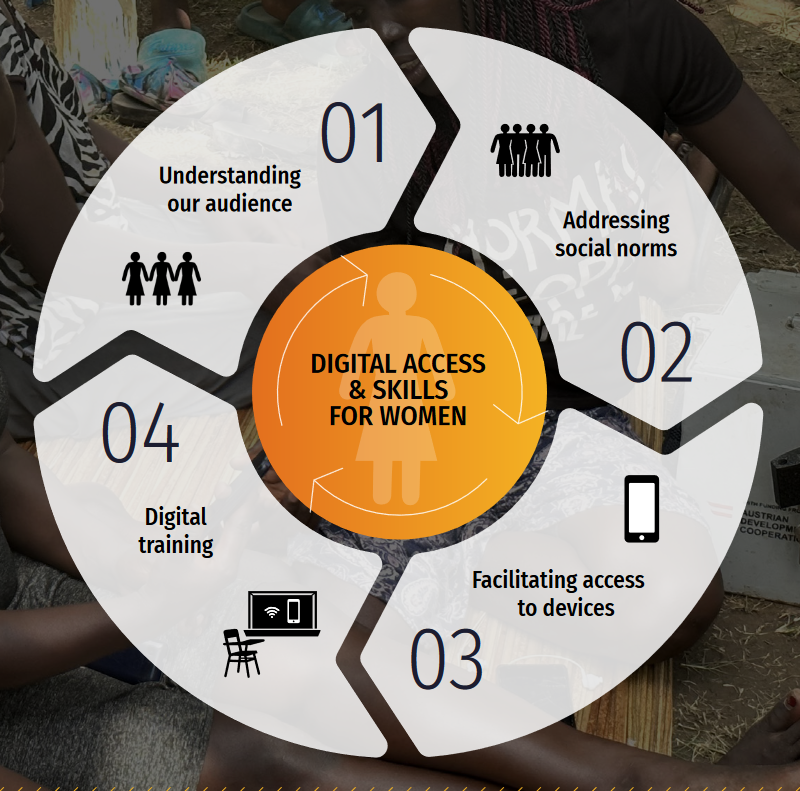Four barriers blocking women from going digital: lessons from a pilot in Rwanda and Uganda
In the digital age, the transformative power of technology is undeniable, particularly in enhancing access to finance and information. However, our experience with Village Savings & Loan Associations (VSLAs) revealed a different reality. While smartphones are often touted as universal tools of empowerment, our pilot project in Uganda and Rwanda, involving 2,605 VSLA members, 79% of whom were women, highlighted the disparity between our initial assumptions and the actual needs of these women.
Initially, we envisioned a scenario where access to smartphones would revolutionize the lives of VSLA members. For a woman farmer in rural Uganda, for example, a smartphone could be a gateway to multiple opportunities – from connecting with buyers and managing farm operations, to accessing vital information on weather patterns and climate-resilient farming techniques. This vision was underpinned by the belief in the smartphone’s capacity to integrate these women more effectively into the digital economy, thereby boosting their financial autonomy and market reach.
However, the COVID-19 pandemic exacerbated the already stark gender digital divide, worsening the economic and social side-lining of women. Data suggests a global trend where women are 17% less likely to own a smartphone compared to men [GSMA, 2023]. Our pilot aimed to explore the root causes of this divide and identify actionable strategies to bridge it. Our approach was not merely to distribute technology, but to reshape the operational dynamics of VSLAs in a digitalizing world. We confronted a harsh reality: beyond the financial hurdle, gender norms were significantly impeding women's access to basic digital literacy and technology usage. This gap was pronounced in our findings, where over 73% of participants did not own a smartphone, and more than a quarter had no access to a phone at all.

Gender norms are restricting women’s digitalization
Through qualitative research conducted at the onset of the pilot, we gained insights into the barriers faced by women in embracing digital technology. These underscored a critical lesson: the importance of centering women's voices in designing and prioritizing digital interventions. The assumption that smartphones are a panacea for women's empowerment in VSLAs was challenged by the reality of their specific needs and circumstances. Here’s what we found:
- Husbands are the primary gatekeepers for married women. Across the board, male partners were cited as the primary barrier because of the power they hold over their female partners. Additional gatekeepers are male relatives, male community or religious leaders, and friends, who discourage a woman from buying a phone because they worry it will cause physical or economic conflict at home.
- It is dangerous to put phones in women’s hands when their male partners do not have one. If a woman has an asset that is considered more valuable than her husband’s – if she has a smartphone but he has a basic phone – she would be under suspicion.
- Affordability is a problem for urban groups. Relevance is the issue for rural groups. The dynamics of smartphone affordability and relevance vary between urban and rural areas. Urban individuals often see these technologies in their daily lives and are better positioned to decide their relevance. Conversely, in rural regions, where mobile phone ownership is significantly lower, exposure to and awareness of smartphone technology is limited.
- Group members place low emphasis on girls’ education. Levels of education are directly related to digital use and control through literacy and numeracy levels, as well as financial capability. With low levels of education, girls’ livelihoods and networks are limited, creating dependency on men for income and making it more difficult for them to identify economic opportunities through digital technology.
Shifting norms
Given the strength of findings around gender norms, we knew we needed to direct our efforts towards individuals and groups that could positively influence the norms around technology access and usage. We did this by engaging male family members, community gatekeepers, and leaders. This approach was critical in reducing potential risks for women participating in VSLAs and securing broader community support for the pilot. By including these influential figures, CARE aimed to create a more accepting and supportive environment for women’s digital engagement.
Through our research we also recognized that local partners would benefit from gender inclusive training, so that those working directly in communities with VSLAs could spread gender transformative digital capability messaging. This included training on how to discuss smartphone and other technology with households, particularly with men who are reluctant or hesitant for their wives to own phones.
Tailored interventions and device access
As part of our research, we developed four distinct ‘personas’ reflecting the different experiences and needs of VSLA members, for example a refugee’s needs may be very different to those of a rural entrepreneur. Different interventions were then mapped for each persona ranging from basic training on feature phones and how to use mobile money through to more advanced training in e-commerce and digital marketing.

As affordability and access to devices was also a major barrier, we formed strategic collaborations with local partners, such as KEIPhone in Uganda. Devices were provided to women at no cost through KEIPhone’s innovative asset financing where lock screen advertising is used to offset the cost of the devices. The primary goal of these collaborations was to build a sustainable and supportive ecosystem.
Ayikoru Sabina, a VSLA member in Uganda, explains the personal impact of the pilot: “The smartphone has made my income generating activity selling food items easier. Customers now send me their orders via WhatsApp and pay via mobile money.”
Where next?
As we move forward, it's evident that tailoring digital solutions to the unique context of women in VSLAs is crucial. Our learnings from this pilot emphasize the need for a more nuanced, women-centric approach in leveraging technology for empowerment, one that aligns more closely with the actual needs and constraints of our participants. This experience has reminded us that in the quest to bridge the digital divide, listening to and prioritizing the voices of women is not just a good practice, but a fundamental necessity.
To our peers and supporters working with savings groups: Join us in integrating women’s digital inclusion into VSLA programming. Together, we can create a digitally inclusive environment where every VSLA member can thrive.
Read our report here Digitization & Gender Norms




